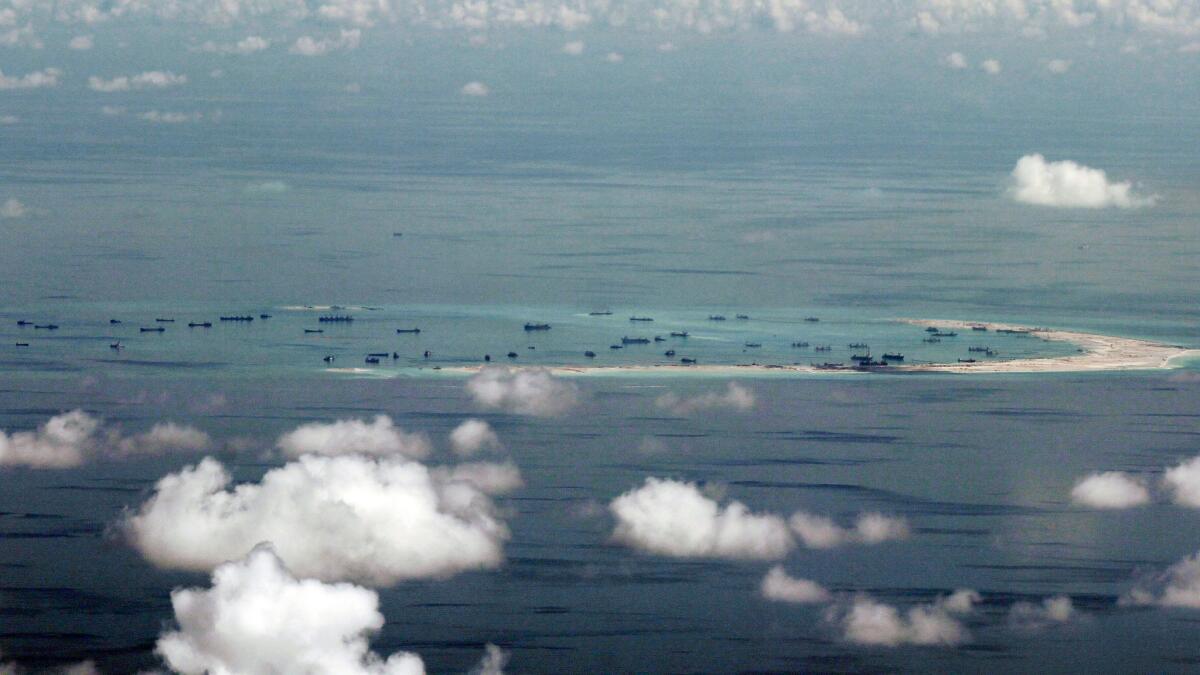International court’s ruling in South China Sea case won’t end the fight

Reporting from Beijing — Three years ago, the Philippines asked an international tribunal to sort out an increasingly testy dispute with China over who’s entitled to do what on and around rocks, reefs and other formations in the South China Sea — a resource-rich zone through which huge quantities of goods and oil are shipped daily.
On Tuesday, the court in The Hague ruled that Beijing’s claims to “historic rights” in the South China Sea are invalid -- but no one expects the decision to end the fight. In fact, the ruling could exacerbate tensions in the region, at least in the short term.
Beijing has vowed it will not accept the ruling, but that doesn’t mean that China won’t react to it, possibly in provocative ways. The Philippines, the U.S. and other nations may also feel compelled to respond.
At the heart of the dispute is what China calls its “nine-dash line” — a U-shaped area of demarcation dipping far off the mainland’s southern coast, sweeping east of Vietnam, down near Malaysia and Brunei, and then looping back up west of the main Philippine islands. The loop encompasses the Paracel and Spratly islands and Scarborough Shoal.
Though China has never explicitly defined what privileges it believes it has within the nine-dash line, it has asserted “historic rights” in the area. The Philippines worries that such a claim could eventually lead China to assert full sovereignty and control over all the land, water, seabed and other atolls and shoals within its boundaries. Other countries, including Malaysia and Vietnam, share similar concerns.
Those fears have multiplied in the last few years as China has rapidly expanded a number of the small land formations it controls, piling huge quantities of sand onto small outcroppings and building landing strips and other facilities. The U.S. has responded by sending military planes and ships into the region to assert “freedom of navigation rights.” On Friday, China began several days of live-fire military exercises in the South China Sea, launching missiles and torpedoes from ships, flying jets in formation and surfacing submarines.
China says that although it is a signatory to the U.N. Convention on the Law of the Sea, the issues at hand involve questions of sovereignty not covered by that agreement. China refused to send a delegation to argue its side in The Hague court; China’s foreign minister, Wang Yi, told U.S. Secretary of State John F. Kerry in a phone conversation last week that the proceedings were a “farce,” China’s official Xinhua News Agency reported.
“Beijing’s position is clear: no acceptance, no participation, no recognition, and no implementation,” Fu Ying, a former vice foreign minister, wrote in a commentary published Sunday in Foreign Policy magazine, part of Beijing’s public relations campaign against the tribunal. Beijing has lined up scores of supporting nations for its position — many of them African countries dependent on China for investment.
But countries including the U.S., Australia, Japan and many European nations have backed the Philippines in its case, warning that if Beijing refuses to accept a decision that goes against its interests, it could open a new era of coercion and intimidation in which an increasingly confident China opts out of international agreements it has signed but later decides it doesn’t like.
Some experts expect the situation to become more tense before it gets better.
“It seems increasingly … likely that Beijing will seek to retaliate in some way, on the ground or in the water, to show it will not be bound by the ruling and will seek to punish Manila for refusing to drop the case,” Gregory B. Poling, director of the Asia Maritime Transparency Initiative at the Center for Strategic and International Studies in Washington, said during a panel discussion last month on the case.
Among the steps China might take, he said, are initiating island-building work on outcroppings it controls in the Scarborough Shoal — a move he said would be “environmentally horrendous” as well as “legally and diplomatically very troubling” because it could create a large Chinese-controlled island 190 nautical miles from Manila.
China could also attempt to reimpose a blockade on Filipino marines stationed on a rusting vessel on Second Thomas Shoal in the Spratlys, Poling said. It could declare an Air Defense Identification Zone in the South China Sea or deploy fighter jets to its newly built airstrips in the Spratlys. If China takes such steps, the U.S. will probably feel compelled to respond.
“The U.S. will likely react with a massive diplomatic campaign against China and send its navy through the region more regularly, to reinforce its demand for comprehensive freedom of navigation,” said Thomas Eder, a research associate at Mercator Institute for China Studies in Berlin. “Other states in the region might feel that they should now quickly follow up and submit their own cases to law of the sea tribunals.”
Eric Shimp, a trade and regulatory advisor with the law firm Alston & Bird, said that could affect commerce.
“An increased military presence and activity by multiple countries means an uptick in the risk of potential conflicts in the region,” he said. “These tensions and the risks they present will need to be navigated by shipping and other companies doing business not just in Asia, but also through the South China Sea, which will translate into added costs in terms of the entire supply chain.”
Longer term, though, some analysts expect that China and other countries with claims in the South China Sea will have to come to the bargaining table, and the tribunal’s decision will be part of the backdrop.
“At some point after the decision is announced, the parties will resume negotiations on the basis of the tribunal’s decision,” Jerome A. Cohen, an expert on law in China and Asia, wrote recently on his blog. “To save China’s face, there would be no need for explicit reference to the arbitration in any agreement that might emerge.”
The Philippines’ foreign secretary, Perfecto Yasay Jr., on Friday told local media the government hoped to quickly begin direct talks with China after Tuesday’s ruling. President Rodrigo Duterte, elected in May, has expressed more of a willingness to negotiate with China than his predecessor.
But how long it will be before negotiations take place is anyone’s guess. “There may be a fairly long period,” Cohen said, “before [China] decides to negotiate on the basis of the arbitration decision.”
MORE WORLD NEWS
Obama leaves final NATO summit with work unfinished on both Afghanistan and Russia
Japan’s ruling coalition wins election, opening door to constitutional change
Egypt wants to revive the Israeli-Palestinian peace process
UPDATES:
July 12, 7:38 a.m.: This article was updated throughout with news of the ruling.
This article was originally published July 11 at 9:48 a.m.
More to Read
Sign up for Essential California
The most important California stories and recommendations in your inbox every morning.
You may occasionally receive promotional content from the Los Angeles Times.











